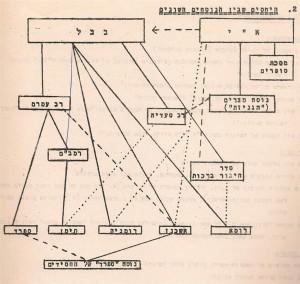DOWNLOAD: PNG | PDF | SVG | ODG (version 0.3.5.4).
Note: The above should be considered a work in progress. Please help to improve it by commenting below. I will update it as new information becomes available.
 The Siddur is an aggregate of thousands of years of creatively inspired work. The organization of the material within any one particular siddur–the textual ingredients and arrangements –represents a specific lineage, or nusaḥ,[1] plural, nusḥaot with its own history of development. There are a good number of different lineages some of which are still alive and changing, others which due to the circumstances of history are now quite obscure. Nevertheless, their voice might still whisper within the pages and tunes of more familiar traditions, if you know where to look.
The Siddur is an aggregate of thousands of years of creatively inspired work. The organization of the material within any one particular siddur–the textual ingredients and arrangements –represents a specific lineage, or nusaḥ,[1] plural, nusḥaot with its own history of development. There are a good number of different lineages some of which are still alive and changing, others which due to the circumstances of history are now quite obscure. Nevertheless, their voice might still whisper within the pages and tunes of more familiar traditions, if you know where to look.
Lawrence A. Hoffman‘s Beyond the Text: A Holistic Approach to Liturgy (Indiana University Press, 1987) provides a flowchart illustrating the developmental history of some familiar liturgical lineages. According to Dr. Richard Sarason (HUC-JIR), the chart is based on one prepared by Dr. Joseph Heinemann for his course on the history of the Siddur at Hebrew University in the mid-1960’s (see right). It appears in Heinemann’s Akadamon choveret, T’filot Yisra’el v’toldotehen: Leqet m’korot (Jerusalem: Hebrew University, 1966) and was copied pretty much verbatim by Jakob J. Petuchowski, Guide to the Prayerbook (Cincinnati: HUC-JIR, 1968) — which is probably where Hoffman discovered it. I was grateful to be introduced to the chart at Yeshivat Hadar where R’ Elie Kaunfer shared it in his class on T’fillah. In the chart one can see how the liturgy of Nusaḥ Ashkenaz largely depends on the “Babylonian Rite” with minor influences directly from the “Palestinian Rite.” Here, Babylonian refers to the nusaḥ seen in development in the Talmud Bavli (Babylonian Talmud) and Palestinian refers to the nusaḥ described in Tannaitic sources and the Talmud Yerushalmi.
Seeing that the design of the map appearing in Hoffman’s book left much to be desired, I redesigned it for clarity while adding some additional nusḥaot. I hope that the following map based on Joseph Heinemann’s work will help inspire fellow researchers to contribute to this project.
The nusḥaot found in Heinemann’s chart are shown in in outlined boxes. Added material is indicated as boxes without outlines. Nusḥaot of which I have scant information I have left without an outline or color.
The map portrays the development of Jewish liturgies over time and is color coded by period, the top of the map showing the earliest nusḥaot and the bottom of the page with the most recent variations. White represents Hebraic traditions before the Babylonian exile (pre-582 BCE). Yellow represents the period of the second temple (roughly 582 BCE to 72 CE). Orange, the Tannaitic and Amoraic period (72 CE to 500 CE). Green, the Geonic period (600 CE to 1000 CE) and light green the period of the Rishonim (1000 CE to 1400 CE). Light blue represents the period between the Spanish expulsion and the Sabbataean controversy (1492 CE to 1666 CE), and the dark blue represents the period of Ḥassidut and the Haskala up until the Holocaust (18th century until 1948). Some of the more recent formulations of these variations as adopted by Jewish communities and particular denominational movements are represented in violet.
In making this, my hope is that it succeeds in portraying the diversity of variations in Jewish liturgical literature as the microforms (i.e., individual prayers) and macroforms (i.e., prayer services) developed across the geographically dispersed communities using them. Having grown up in synagogues offering a variety of siddurim on their shelves, I also hope that representing this historical and literary diversity in t’fillah will be an inspiration to individuals engaging in davvening as an intellectually engaged and creative discourse speaking across generations. In a very basic way, this is a goal of mine in realizing the Open Siddur Project. The extent to which we’ll be able to realize this vision will be limited to how many source texts we’ll be able to identify, transcribe, and share with open standards and free culture licenses.
Notes
| 1 | plural, nusḥaot |
|---|

